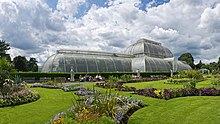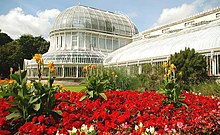
The National Botanic Gardens is a botanical garden in Glasnevin, 5 km north-west of Dublin city centre, Ireland. The 19.5 hectares are situated between Glasnevin Cemetery and the River Tolka where it forms part of the river's floodplain.
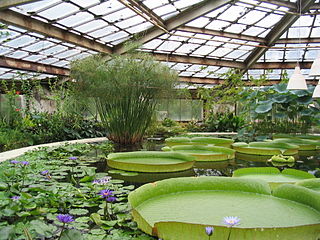
A greenhouse is a special structure that is designed to regulate the temperature and humidity of the environment inside. There are different types of greenhouses, but they all have large areas covered with transparent materials that let sunlight pass and block it as heat. The most common materials used in modern greenhouses for walls and roofs are rigid plastic made of polycarbonate, plastic film made of polyethylene, or glass panes. When the inside of a greenhouse is exposed to sunlight, the temperature increases, providing a sheltered environment for plants to grow even in cold weather.

A conservatory is a building or room having glass or other transparent roofing and walls, used as a greenhouse or a sunroom. Usually it refers to a space attached to a conventional building such as a house, especially in the United Kingdom. Elsewhere, especially in America, it can often refer to a large freestanding glass-walled building in a botanic garden or park, sometimes also called a palm house if tall enough for trees. Municipal conservatories became popular in the early 19th century.
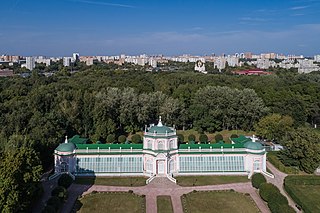
An orangery or orangerie is a room or dedicated building, historically where orange and other fruit trees are protected during the winter, as a large form of greenhouse or conservatory. In the modern day an orangery could refer to either a conservatory or greenhouse built to house fruit trees, or a conservatory or greenhouse meant for another purpose.
The Buffalo and Erie County Botanical Gardens are botanical gardens located within South Park in Buffalo, New York, United States. These gardens are the product of landscaping architect Frederick Law Olmsted, glass-house architects Lord & Burnham, and botanist and plant-explorer John F. Cowell.

The Conservatory of Flowers is a greenhouse and botanical garden that houses a collection of rare and exotic plants in Golden Gate Park, San Francisco, California. With construction having been completed in 1879, it is the oldest building in the park. It was one of the first municipal conservatories constructed in the United States and is the oldest remaining municipal wooden conservatory in the country. For these distinctions and for its associated historical, architectural, and engineering merits, the Conservatory of Flowers is listed on the National Register of Historic Places and the California Register of Historical Places. It is a California Historical Landmark and a San Francisco Designated Landmark.

Phipps Conservatory and Botanical Gardens is a botanical garden set in Schenley Park, Pittsburgh, Pennsylvania, United States. It is a City of Pittsburgh historic landmark and is listed on the National Register of Historic Places.
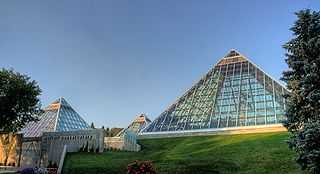
The Muttart Conservatory is a botanical garden in the North Saskatchewan river valley, across from the downtown core in Edmonton, Alberta, Canada. One of the best-known landmarks of Edmonton, the conservatory consists of three city-operated greenhouses, public gardens, as well as four feature pyramids for display of plant species found across three biomes, with the fourth pyramid hosting a seasonal display. A fifth minor skylight pyramid lights up the central foyer.
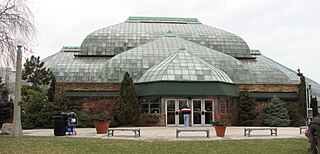
The Lincoln Park Conservatory is a conservatory and botanical garden in Lincoln Park in Chicago, Illinois. The conservatory is located at 2391 North Stockton Drive just south of Fullerton Avenue, west of Lake Shore Drive, and part of the Lincoln Park, Chicago community area. The Alfred Caldwell Lily Pool and the North Pond Nature Sanctuary are further to the north along Stockton Drive. Along with the Garfield Park Conservatory on Chicago's west side, the Lincoln Park Conservatory provides significant horticultural collections, educational programs and community outreach efforts.

Franklin Park Conservatory and Botanical Gardens is a botanical garden and conservatory located in Columbus, Ohio. It is open daily and an admission fee is charged. Today, it is a horticultural and educational institution showcasing exotic plant collections, special exhibitions, and Dale Chihuly artworks.
Lord & Burnham was a noted American boiler and greenhouse manufacturer, and builders of major public conservatories in the United States.

The Volunteer Park Conservatory is a botanical garden, conservatory, and Seattle landmark located in Seattle, Washington at the north end of Volunteer Park on Capitol Hill.

Kew Gardens is a botanic garden in southwest London that houses the "largest and most diverse botanical and mycological collections in the world". Founded in 1840, from the exotic garden at Kew Park, its living collections include some of the 27,000 taxa curated by Royal Botanic Gardens, Kew, while the herbarium, one of the largest in the world, has over 8.5 million preserved plant and fungal specimens. The library contains more than 750,000 volumes, and the illustrations collection contains more than 175,000 prints and drawings of plants. It is one of London's top tourist attractions and is a World Heritage Site.

The Enid A. Haupt Conservatory is a greenhouse at the New York Botanical Garden (NYBG) in the Bronx, New York, United States. The conservatory was designed by Lord & Burnham Co. in the Italian Renaissance style. Its major design features are inspired by the Palm House at the Royal Botanic Gardens at Kew, and Joseph Paxton's Crystal Palace.

The Wüstenhaus Schönbrunn is a desert botanical exhibit in Vienna, Austria. It is located in the Sonnenuhrhaus, which was built in 1904 as the newest of the four botanical houses in Schönbrunn Palace Park. The desert exhibit opened in 2004 as a counterpart to the "Rainforest House" that opened in 2002 in the nearby Vienna Zoo.

The Palmenhaus Schönbrunn is a large greenhouse in Vienna, Austria featuring plants from around the world. It opened in 1882. It is the most prominent of the four greenhouses in Schönbrunn Palace Park, and is also among the largest botanical exhibits of its kind in the world, with around 4,500 plant species.

Allan Gardens is a conservatory and urban park located in the Garden District of Toronto, Ontario, Canada. The property includes a playground, off-leash dog park, and a 1,500 square metres (16,000 sq ft) conservatory with six green houses.

The Hill Garden is a historic botanical garden, one of the gardens of the Herrenhäuser Gärten, around the residence Herrenhäuser Schloss in Herrenhausen, now part of Hanover, Lower Saxony, Germany. The garden was first created in 1666 as a vegetable garden on a hill north of the palace, and then transformed into a garden for exotic plants. In 1750, it was developed into a botanical garden, with some unusual trees from the period still surviving. It features a palm house, first built in 1846, and a mausoleum, where members of the royal family were interred. Damaged by air raids in World War II, the gardens were restored. In 2000, a house for rain forest-themed gardens was added, which was transformed to an aquarium in 2007.

The Anna Scripps Whitcomb Conservatory is a greenhouse and a botanical garden located on Belle Isle, a 982-acre (397-hectare) island park located on the Detroit River within Detroit, Michigan. While located near the Canada–United States border, the island is entirely within the U.S. The park itself consists of 13 acres of preserved land for the conservatory and its botanical garden.

The Palm House is a large palm house in the Royal Botanic Gardens, Kew, in London, that specialises in growing palms and other tropical and subtropical plants. It was completed in 1848. Many of its plants are endangered or extinct in the wild. Features include an upper walkway, taking the visitor into the branches of the larger plants. Kew also has the even larger "Temperate House", kept at lower temperatures.

